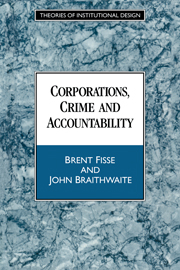Book contents
- Frontmatter
- Contents
- Preface
- Abbreviations
- 1 Crime, Responsibility and Corporate Society
- 2 Individualism
- 3 Enterprise Liability
- 4 Organisation Theory Perspectives
- 5 Making the Buck Stop
- 6 Assessing the Accountability Model
- 7 The Possibility of Responsibility for Corporate Crime
- Bibliography of Cited Works
- Index
7 - The Possibility of Responsibility for Corporate Crime
Published online by Cambridge University Press: 11 March 2010
- Frontmatter
- Contents
- Preface
- Abbreviations
- 1 Crime, Responsibility and Corporate Society
- 2 Individualism
- 3 Enterprise Liability
- 4 Organisation Theory Perspectives
- 5 Making the Buck Stop
- 6 Assessing the Accountability Model
- 7 The Possibility of Responsibility for Corporate Crime
- Bibliography of Cited Works
- Index
Summary
Corporate Crime Control: Complexity and Multiplexity
Corporate crime is a greater threat to humankind today than at any time in the past. Our planet is more fragile than ever and therefore more at risk from the predations of environmental criminals. Our economy is more internationalised, and therefore more vulnerable to sophisticated criminals who use the corporate form to run an international law evasion game—playing one set of laws off against another. Worse, as in the BCCI case, large corporations can effectively avoid national laws by setting themselves up in such a way that no national regulator is their home regulator.
Our economies are also more in flux than ever. The marketplace is more open to radical new ideas about how to organise business and, as evidenced by leveraged buyouts, poison pills, and junk bonds, those ideas can sweep through capitalist markets overnight. We have now learnt that when the organisation that invents an idea like junk bonds is a systemic law-breaker, and when the junk-bond ‘king’ (Michael Milken) is a criminal, the entrepreneurship that can fundamentally transform the face of capitalism (as junk bonds did in the 1980s) can also be a dire threat to its health.
In a dynamic corporate economy, criminal law models that were designed to stabilise individual criminal liability are doomed to fail. The more flux there is in the economy, the more the uncertainty about the likely efficacy of any control strategy. Given the escalating uncertainty, the more imperative it becomes to have a dynamic and diversified strategy.
- Type
- Chapter
- Information
- Corporations, Crime and Accountability , pp. 218 - 238Publisher: Cambridge University PressPrint publication year: 1994



